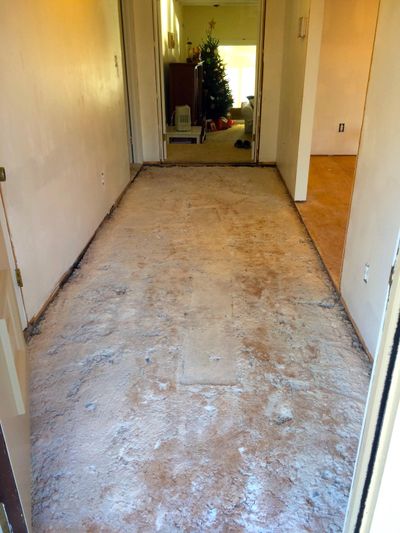Ask the Builder: Concrete mortar bed makes excellent base for laminate flooring

DEAR TIM: I’m renovating a 1969 ranch home that’s over a crawl space. I pulled up the existing foyer tile floor so I can put down interlocking laminate or engineered flooring. Much to my surprise, I found a concrete mortar bed under the tile. I’m assuming I must remove the mortar and add more wood sub-flooring on top of the existing plywood subfloor. Is that a correct assumption? The mortar sits, on average, about 1 inch below the existing finished floors. What would you do at this point? How would you deal with this wretched concrete mess? – Dave H., Charlotte, North Carolina
DEAR DAVE: What’s that old saying? “One man’s trash is another man’s treasure.” Yeah, that’s it. My friend, all I can say is you’ve been blessed. I recommend that you prance around your house singing “Happy Days Are Here Again.” That concrete mortar floor is an excellent base for your new laminate floor once you dress it up.
Allow me to share a story. A friend of mine bought an older home in the town where I live. She and her boyfriend embarked on lots of remodeling to this tired, old one-bedroom home.
One of the last projects they tackled was installing a laminate floor. This woman knows that I have a little bit of knowledge about matters of home construction and remodeling, yet she didn’t call me up. I think it might have had something to do with belittling her boyfriend’s skills. It’s too bad that as most people get older, their egos get more fragile, but that’s a story for another day.
I don’t know if they hadn’t read or just didn’t understand the laminate flooring instructions, if they were in a rush, were too tired at the end of the job or thought they knew better, but they made a grievous error.
Interlocking laminate flooring is a very interesting product. I put down one in my man cave ham-radio shack about three years ago that looks like random-width v-groove distressed oak flooring. Everyone that’s seen it thinks that it’s real oak and that the floor is perhaps 50 or more years old. It looks that good.
I read the installation instructions, and they state that the flooring must be installed on a solid floor that’s all in the same plane. This means the sub-flooring shouldn’t move or flex, and it must be smooth with no humps or low spots. If you don’t satisfy these basic requirements, the laminate flooring will snap, crackle and pop as you walk across it.
My friend made this mistake and her floor creaks and snaps as she walks across it. She called me a month after the install to ask if there was a way to repair it. I told her she might be able to inject a material, with great effort, under the floor in the worst spots, but that the best way was to disassemble the floor, get the subfloor in the same plane, and re-install the flooring. She chose not to do that.
How does all this relate to you? Simple. That concrete mortar floor is nearly as solid as the Rock of Gibraltar. I’m pretty certain a month ago, before you started the demolition, when you walked across that tile foyer floor you felt like you were on bedrock. That satisfies the first requirement for a laminate floor. Your subfloor is solid with no flex.
The issue you have now is the concrete is not in the same plane. The concrete mortar is uneven, it’s gross and it’s well below the level of the existing floors in the adjacent rooms. That’s easy to fix with a self-leveling pourable floor compound.
You have a unique opportunity at this point to install an electric radiant heat mat if the floor needs extra heat. If this were a bathroom you were working on, I’d insist on it. I have a mat like this in my man cave under my laminate flooring and it produces a luxurious heat. Last year I had the opportunity to retrofit my master bathroom floor with radiant heating and my wife’s feet are toasty warm now on frigid winter mornings. The bathroom is also much warmer with the extra heat.
Your task at this point is to add just enough self-leveling compound so the top of the laminate flooring will be flush with the adjacent rooms. With luck, the original builder made all the floors flush with the tile, so this should be an easy task.
Read the instructions on the self-leveling floor compound. My guess is you’ll want to use a wet-dry vacuum to get all grit and dust up from the concrete mortar. Since self-leveling compounds require water to mix them, it might be a good idea to spritz the concrete mortar with water just before covering it with the self-leveling mixture. This ensures you’ll get a great bond and the concrete mortar won’t suck too much water from the leveling compound too fast.
If that happens, the compound may not flow like it should, which is necessary to give you that smooth level surface. I recommend that you experiment with a bag of the self-leveling compound to make sure you have a feel for how it works. Build a small rectangular frame out of 3/4-inch trim lumber that’s 2-feet-by-4-feet. Set it on a sheet of 6 mil plastic on your garage floor. Mix up some compound and pour away. The plastic will keep it from bonding to your garage floor.
Need an answer? All of Carter’s past columns are archived for free at www.AsktheBuilder.com. You can also watch hundreds of videos, download Quick Start Guides and more, all for free.